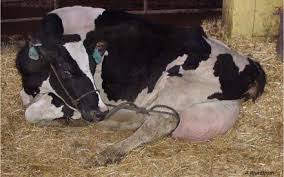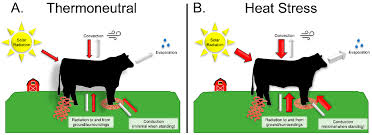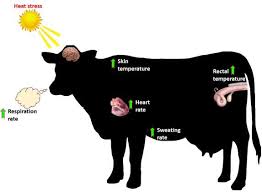This article presents for study, the physiological factors contributing to heat load in farm animals using cattle as an example. The methods used to alleviate the heat load are also discussed.
Read Also: How to Grow, Use and Care for Whitetinge Sedge Grass (Carex albicans)
Understanding Physiological Factors Contributing to Heat Load in Farm Animals

Although when cattle are exposed to high temperatures, the chief cause of heat loss from the animal is by evaporation of water from the internal and external body surfaces, water evaporation is not the only means by which animals may lose heat.
The following equation, often spoken of as the ‘homeothermic equation’, indicates all the various ways by which an animal may lose or gain heat from its environment:
M-E-F-Cd-Cv-R-0
Where:
M = the metabolic heat produced by the living animal;
E = the heat lost through evaporation of water from the body surfaces;
F = the heat lost by the consumption of feed which is either hotter or cooler than the body temperature;
Cd = the heat lost by conduction (i.e., the transfer of heat energy from particle to particle by increased molecular activity);
Cv = the heat lost by convection (i.e., the transfer of heat energy by a circulation of heated material, usually air);
R = the heat loss through radiation (i.e., the transfer of energy across space without heating the space through which it passes).
Where the environmental temperature is above the normal body temperature, a cow clearly cannot lose heat to its environment by convection, conduction, or radiation.
The animal may possibly lose heat if, during the period of heat stress, it ingests river or well water, which will invariably be below body temperature, rather than taking in water which has been standing in an exposed trough or shallow pond.
Read Also: How to Grow, Use and Care for Whitegrass (Leersia virginica)
Effects of Solar Radiation on Heat Load in Farm Animals

It is pertinent to add a comment at this stage concerning the various ways by which the animal is affected by the radiation received from the sun. Radiation may be divided into infrared or heat radiation (long wavelengths), visible light (medium waves), and ultraviolet radiation (short waves).
The proportion of long and medium waves in the total radiation will increase as one moves from the poles towards the equator. The proportion of short waves present in the radiation will increase as one moves from sea level to high altitudes. It follows that the greatest radiation intensity is found on farm animals kept at a high altitude on the thermal equator.
The coat will absorb most of the infrared radiation received by the animal. The characteristics of skin colour will influence this absorption since light, sleek hairs will enable a proportion of the infrared radiation to be reflected. The visible light falling on the animal can also be readily reflected, the amount equally depending upon the physical characteristics of the coat surface.
In this article, it has been shown that there are many physiological processes that contribute to heat load in the animal. The main ones are metabolism, maintenance, exercise, growth, lactation, gestation, and feeding. There are ways too to lose heat either through the environment or through some physiological processes.
Do you have any questions, suggestions, or contributions? If so, please feel free to use the comment box below to share your thoughts. We also encourage you to kindly share this information with others who might benefit from it. Since we can’t reach everyone at once, we truly appreciate your help in spreading the word. Thank you so much for your support and for sharing!

